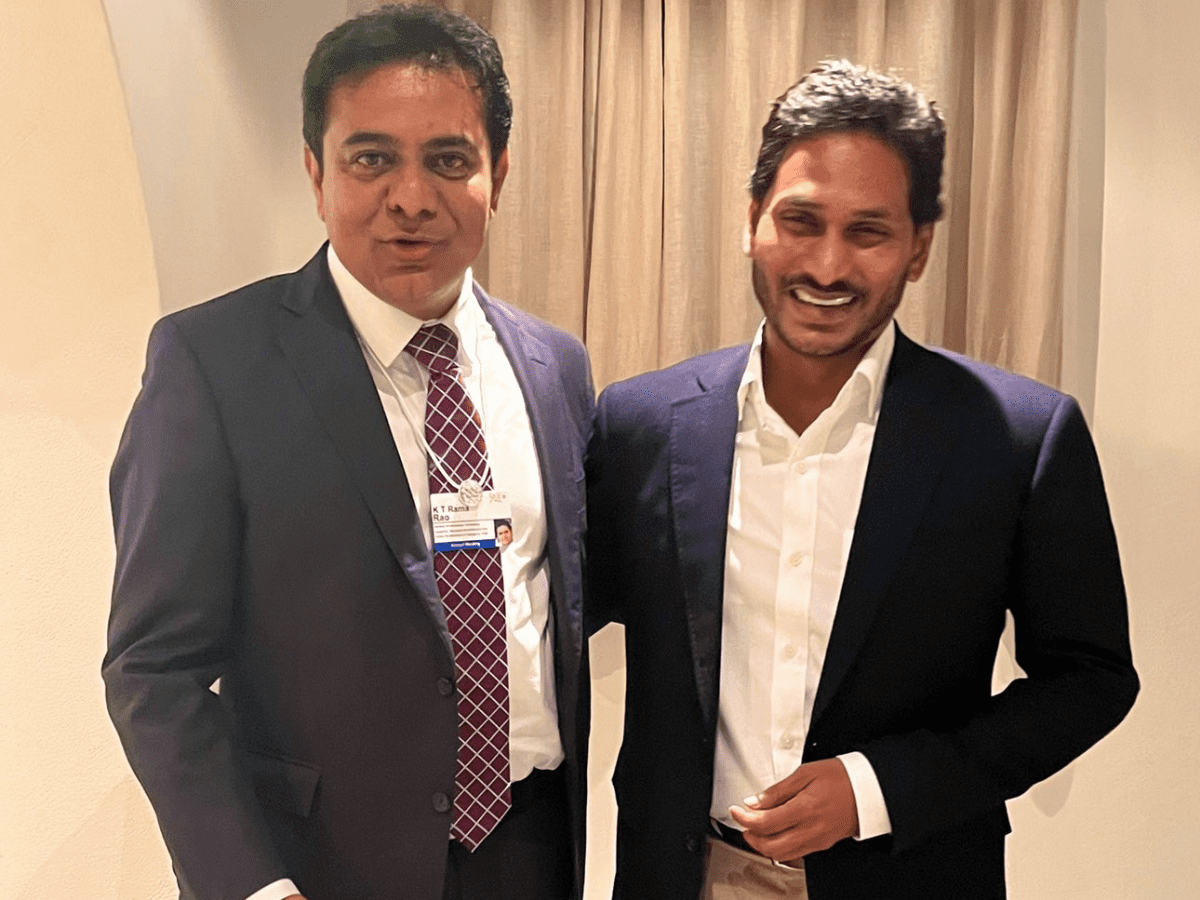
The Annual World Economic Forum Summit in Davos has emerged as an attractive platform for Indian leaders. The Central and the State Governments leaders make high-profile visits to Davos, ostensibly to court investments.
Over the years, it has grown in stature. Now, it has reached a point where delegates can only come on the invitation and have to pay a whopping Rs 2.35 lakh as a registration fee.
Heads of governments, ministers, and business leaders come to address, interact, impress and showcase to a gathering of one of the most economically powerful men and women in the world, who meet at Davos every year, usually in January. This time around, it was delayed, because of the Covid pandemic, holding it from May 22-26.
Futile Exercise
When Government leaders make a pitch at that level, outcomes should truly be very spectacular. However, past experience has shown that such exercises have not proved to be very fruitful and even turned out to be futile. Such high-profile visits by Government leaders do not yield really commensurate results, in terms of investment flows.
Apparently, there is a need to identify what is holding back the flow of investments and address the same. What is needed is a strong mechanism to identify what is really holding backflow of capital. This requires both on-the-ground, first-hand information and keeping sight of the larger perspective.
Essentially, the challenge is to attract investments. It requires more practical ways, of a possible dialogue between the prospective investors and policymakers. In such an arrangement, investors and firms can identify the sticky issues. Policymakers, on the other hand, can then help address the same. Only then, it can prove to be fruitful.
Davos can at best be useful to announce and showcase a new policy paradigm, which can help in greater outreach. For instance, in the wake of the Economic Reforms in 1991, the then Prime Minister P V Narasimha Rao visited Davos in 1992 and presented the Bypass Model and the Middle Path. Since Narasimha Rao brought about a paradigm shift in the economic policy, visiting Davos to make a presentation made sense. But, in the normal course, it seems unlikely to make any major impact.
Indian Story
The Modi Government was represented by three Union Ministers, Union Commerce Minister Piyush Goyal, Union Health Minister Mansukh Mandaviya, and Union Petroleum Minister Hardeep Puri. Besides, nearly 100 business leaders from India also participated in the event.
Piyush Goyal expressed the hope India’s participation in the World Economic Forum Annual Meeting 2022, will help reinforce India’s crucial role as a rising economic powerhouse. It will project India as an attractive hub for business and investment, globally.
Top industrialists in Davos included Shobana Kamineni, Gautam Adani, Sanjiv Bajaj, Hari S Bhartia, Shyam Sunder Bhartia, Kumar Mangalam Birla, Rajan Mittal, Sunil Mittal, Pawan Munjal and a large number of young Indian business leaders.
Issues that cast a shadow on discussions in Davos included the Ukraine Conflict, Climate Change, and preparing a pandemic-ready world.
The Indian story at Davos this time had a key component of various states making their respective strong pitch for investments and global collaborations. Though the trend was in evidence earlier, this time round, there was a greater push from the States.
Jagan, KTR in Davos
The prominent States present in Davos included Andhra Pradesh, Telangana, Karnataka, Tamil Nadu, and Maharashtra. Andhra Pradesh Chief Minister YS Jagan Mohan Reddy led the State pitch at Davos. So was the case, with Karnataka Chief Minister Basavaraj Bommai leading his State pitch.
Telangana Chief Minister K Chandrashekhar Rao’s son KT Rama Rao and Maharashtra Chief Minister Uddhav Thackeray’s son Aditya Thackeray, both Ministers in their respective States, were present in Davos.
KT Rama Rao made a strong pitch for presenting Telangana as a key investment destination and innovator. On the other hand, Karnataka Chief Minister Basavaraj Bommai expressed confidence about attracting more investments into the State
Now, Hyderabad, in the past, has already attracted investments and it has emerged as a major destination for global companies. Hyderabad has natural advantages in terms of its location and connectivity. As such, there is nothing added to it by the TRS Government. The high pitch of K T Rama Rao does not either add or contribute to it now, in any manner.
AP Woes
As far as Andhra Pradesh is concerned, following the Bifurcation in 2014, when Telangana was carved out, it has suffered from certain drawbacks.
At the time of Bifurcation in 2014, Andhra Pradesh was a power-surplus State, while Telangana was a power-deficit State. In a reversal of roles, Andhra Pradesh now faces load-shedding, while Telangana has become a power-surplus State. Unless and until Andhra Pradesh improves its power situation, it cannot hope to attract investors.
What is more, Andhra Pradesh does not enjoy easy connectivity. In fact, connectivity is essential not only for ease of movement of prospective investors, but also for moving the finished goods.
To overcome the problem of connectivity, Andhra Pradesh could consider a port-led strategy for the movement of finished goods, as also as exports.
Industrial Incentives
During the passage of the Andhra Pradesh Reorganization Act, 2014, the Centre offered Special Category Status for Andhra Pradesh.
In fact, YSRCP Supremo YS Jagan Mohan Reddy came to power on the promise that if given 25 MPs, he will compel the Centre to grant Special Category Status to Andhra Pradesh. People trusted him and elected all the 25 MP candidates of the YSRCP in 2019.
Far from compelling the Centre, Jagan Mohan Reddy did not even mention Special Category Status for Andhra Pradesh. He has reneged on his promise to secure Special Category Status for Andhra Pradesh.
The only solution for Andhra Pradesh is the Special Category Status. That is because it provides industrial incentives, which can help attract investors to the State.
AP, Adani Green MoU
A Memorandum of Understanding (MoU) was signed between Andhra Pradesh Government and Adani Green Energy for Rs 60,000 crore.
Question is, should Jagan Mohan Reddy have traveled to Davos to sign MoU with Adani?
Jagan Mohan Reddy wants to develop Visakhapatnam as Technology Hub with focus on Artificial Intelligence (AI) and he reportedly sought investments in that sector. Executive Vice-President of Dassault Systems, Florence Verzelen also interacted with Andhra Pradesh Chief Minister YS Jagan Mohan Reddy.
Babu in Davos
Former Andhra Pradesh Chief Minister N Chandrababu Naidu was chosen as Special Invitee nearly thrice for the Davos Summit. Towards the end of his tenure in office, Lokesh also visited Davos.
Once, Chandrababu Naidu was invited for a session on the Future of Urban Development, where he pitched his vision for Andhra Pradesh and its goals. Davos is perhaps good only to that extent and not beyond that.
In Visakhapatnam, Chandrababu Naidu also staged a two-day AP-CII Partnership Summit in January, 2017. It saw the signing of 665 Memorandum of Understanding (MoUs) worth Rs10.54 trillion, with potential to provide employment to 22.34 lakh people.
The moot question is how much of it has actually translated into investment in the State?
Davos can only have limited value for wider interactions, but it provides no solutions to the ailing State. What is required is a strong political will, to fix the same and to create a climate conducive to the flow of investments.

